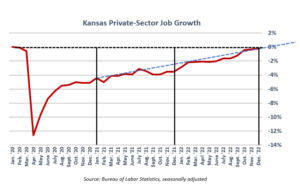In December 2022, Kansas was still 2,700 private-sector jobs below its pre-pandemic numbers while 30 states have already fully recovered. Failing to achieve this benchmark while a majority of the country has is a sign that Kansas needs more than ineffective economic subsidies and lackluster tax policy to grow.
The Bureau of Labor Statistics adjusts its estimates monthly for more accuracy, so November’s original private-sector job report of 1,162,500 jobs was increased to 1,164,700 jobs. Meaning that Kansas ended with 1,165,800 jobs, it gained 1,100 jobs and grew by 0.1% compared to last month.
 This month, Iowa joined the 29 other states across the country that have fully recovered to their pre-pandemic jobs numbers. All of Kansas’s neighbors have fully recovered as well.
This month, Iowa joined the 29 other states across the country that have fully recovered to their pre-pandemic jobs numbers. All of Kansas’s neighbors have fully recovered as well.
The biggest gains by sector came from Trade, Transportation, and Utilities which gained 1,600 jobs, Construction which gained 600 jobs, and Manufacturing gained 500 jobs. Meanwhile, Professional and Business Services lost 1,600 jobs. There were gains and losses of less than 300 jobs in other industries. At the same time, government lost 600 jobs total accounting for a loss of 700 state jobs but a gain of 100 local jobs.
The unemployment rate increased from 2.8% to 2.9%. However, the number of unemployed people increased by 1,241 while the number of employed people increased by 2,682 and the labor force participation rate went up from 66.0% to 66.1%. This is all to say that the number of people trying to find and engage in work is increasing, which makes job growth even more critical so that they have more job opportunities.
Kansas’s economic policy isn’t working
The definition of insanity is doing the same thing over and over and expecting a different result. Kansas ranks in the bottom half of states when it comes to growth in private-sector jobs, GDP, wages, and domestic migration, yet continues a faulty business development agenda that hasn’t given the state a “shot of adrenaline.”
Governor Laura Kelly’s business policy is rooted in subsidies for big businesses, with the crown jewel being APEX recipients like the Panasonic megaproject in Johnson County that may receive over $1 billion in subsidies… while at the same time, they have no wage or hiring requirements, indefinite nondisclosure agreements, and confidential investment details. Now, the Department of Commerce wants more billion-dollar deals for semiconductor facilities.
Business subsidies in Kansas have long been shown to have little to no effect on growth, instead moving around jobs versus creating them. A study of the state’s PEAK program (Promoting Employment Across Kansas) by Professor Nathan Jensen currently at the University of Texas, Austin found that PEAK recipients were no more likely to create jobs than non-PEAK recipients. Dr. Arthur Hall, Executive Director of the Brandmeyer Center for Applied Economics at the University of Kansas, reached a similar conclusion in a study of STAR bond projects in Wichita.
But a Kansas Legislative Division of Post Audit report released last week further found that a sample of the state’s 5 incentive programs yielded positive total returns…but did not generate enough tax effects to cover their costs.
Currently, Kansas has the highest effective tax rates on mature tech businesses: reducing these rates is a much more direct way to promote business growth than multi-billion dollar subsidies. An OECD study reports that after corporate income taxes, personal income taxes are the second most harmful tax to economic growth. Small rate reductions to personal income taxes in Kansas would make the state more attractive for domestic migration.
Kansans need lower state and local taxes, which can be paid for by reducing the cost of government. Streamlining the regulatory burden would also create economic growth for businesses and individuals. Kansas will eventually recover its pre-pandemic jobs, but the question is whether sluggish growth will continue and put the Sunflower State farther behind its neighbors.





